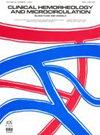Rosuvastatin inhibit ox-LDL-induced platelet activation by the p38/MAPK pathway.
IF 2.1
4区 医学
Q3 HEMATOLOGY
引用次数: 0
Abstract
OBJECTIVE This study intends to explore the effects of Rosuvastatin on ox-LDL induced platelet activation and its molecular mechanism. METHODS Platelet aggregation rate was detected by aggregometer. ELISA kit was used to detect the levels of cAMP. Immunofluorescence staining was used to detect the platelet adhesion. The expression levels of platelet surface markers CD62p and PAC-1 were detected by flow cytometry. The protein levels of p-p38, p-IKKa and p-IKKB in platelets were detected by western blot. RESULTS We found that rosuvastatin significantly inhibited platelet aggregation and increased the level of cAMP in a dose-dependent manner. Immunofluorescence staining results showed that rosuvastatin could inhibit platelet adhesion. Flow cytometry results showed that rosuvastatin could reduce the expression of platelet activation markers. Western blot results showed that rosuvastatin could down-regulate the expression levels of p-p38, p-IKKa and p-IKKb. CONCLUSION Our study revealed the rosuvastatin could inhibit the aggregation, adhesion and activation of platelet induced by ox-LDL, its mechanism may be related to inhibition of p38/MAPK signal pathway.瑞舒伐他汀通过 p38/MAPK 通路抑制氧化-LDL 诱导的血小板活化。
目的:本研究旨在探讨瑞舒伐他汀对氧化-LDL诱导的血小板活化的影响及其分子机制。方法:用聚集仪检测血小板聚集率。使用 ELISA 试剂盒检测 cAMP 水平。免疫荧光染色检测血小板粘附情况。流式细胞仪检测血小板表面标志物 CD62p 和 PAC-1 的表达水平。结果 我们发现罗伐他汀能显著抑制血小板聚集,并以剂量依赖的方式增加 cAMP 的水平。免疫荧光染色结果显示,罗伐他汀可抑制血小板粘附。流式细胞术结果显示,罗伐他汀可降低血小板活化标志物的表达。Western印迹结果表明,罗伐他汀可下调p-p38、p-IKKa和p-IKKb的表达水平。结论我们的研究发现,罗伐他汀可抑制ox-LDL诱导的血小板聚集、粘附和活化,其机制可能与抑制p38/MAPK信号通路有关。
本文章由计算机程序翻译,如有差异,请以英文原文为准。
求助全文
约1分钟内获得全文
求助全文
来源期刊
CiteScore
4.30
自引率
33.30%
发文量
170
期刊介绍:
Clinical Hemorheology and Microcirculation, a peer-reviewed international scientific journal, serves as an aid to understanding the flow properties of blood and the relationship to normal and abnormal physiology. The rapidly expanding science of hemorheology concerns blood, its components and the blood vessels with which blood interacts. It includes perihemorheology, i.e., the rheology of fluid and structures in the perivascular and interstitial spaces as well as the lymphatic system. The clinical aspects include pathogenesis, symptomatology and diagnostic methods, and the fields of prophylaxis and therapy in all branches of medicine and surgery, pharmacology and drug research.
The endeavour of the Editors-in-Chief and publishers of Clinical Hemorheology and Microcirculation is to bring together contributions from those working in various fields related to blood flow all over the world. The editors of Clinical Hemorheology and Microcirculation are from those countries in Europe, Asia, Australia and America where appreciable work in clinical hemorheology and microcirculation is being carried out. Each editor takes responsibility to decide on the acceptance of a manuscript. He is required to have the manuscript appraised by two referees and may be one of them himself. The executive editorial office, to which the manuscripts have been submitted, is responsible for rapid handling of the reviewing process.
Clinical Hemorheology and Microcirculation accepts original papers, brief communications, mini-reports and letters to the Editors-in-Chief. Review articles, providing general views and new insights into related subjects, are regularly invited by the Editors-in-Chief. Proceedings of international and national conferences on clinical hemorheology (in original form or as abstracts) complete the range of editorial features.

 求助内容:
求助内容: 应助结果提醒方式:
应助结果提醒方式:


